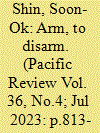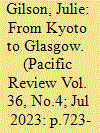|
|
|
Sort Order |
|
|
|
Items / Page
|
|
|
|
|
|
|
| Srl | Item |
| 1 |
ID:
192549


|
|
|
|
|
| Summary/Abstract |
North Korea is a de facto nuclear weapon state, having undertaken six tests between 2006 and 2017. Throughout a series of nuclear crises, since the early 1990s, Pyongyang has not only emphasised its sovereign right to explore nuclear options as an inevitable response to a hostile United States, but has at the same time consistently embraced an anti-nuclear stance, maintaining a commitment to the ‘denuclearisation of the Korean Peninsula’. This nuclear posture – ‘arm, to disarm’ – stressing the inevitability of nuclear-arming while at the same time pledging a normative anti-nuclear commitment to denuclearisation, contains seemingly irreconcilable elements. This challenges rationalist IR theories, which are unable adequately to explain the DPRK’s position, characterising it as either a tactical diversion to disguise realist motivations or a negotiation leverage to induce economic and strategic concessions. This article offers an alternative analysis, seeking to decode the DPRK’s seemingly contradictory nuclear posture by arguing that its anti-nuclear posture has deep Cold War roots aimed at hedging its security inferiority vis-à-vis nuclear-armed enemies. It focuses on the Cold War security nexus in East Asia and examines how Pyongyang’s engagement in the anti-nuclear movement evolved to shape its seemingly irreconcilable ‘arm, to disarm’ nuclearism.
|
|
|
|
|
|
|
|
|
|
|
|
|
|
|
|
| 2 |
ID:
192552


|
|
|
|
|
| Summary/Abstract |
As far as space technology cooperation is concerned, China and Russia took the Ukraine crisis in 2014 as the dividing line. The content and methods of cooperation between the two countries have undergone significant changes, making the cooperation from simple to complicated. Meanwhile, the space technology cooperation between China and Russia will definitely shape the structure of power in space geopolitics among China and Russia and US, which helps to create a balance of power and prevent the emergence of a Kindleberger trap in space geopolitics, but to a certain extent, will in turn restrict China-Russia space technology cooperation and have an important impact on China-Russia strategic partnership of coordination. The deepening of space technology cooperation between China and Russia may increasingly show the nature of power competition in space geopolitics.
|
|
|
|
|
|
|
|
|
|
|
|
|
|
|
|
| 3 |
ID:
192546


|
|
|
|
|
| Summary/Abstract |
The term ‘climate leadership’ became popular in the 1990s, in relation to international negotiations aimed at reducing greenhouse gas emissions and other environmental mitigations. Since that time, international attention – borne out by scientific study and a rapidly changing planetary climate - has shifted from global warming, the ozone layer and greenhouse gas emissions, to energy production, scientific innovation, and, by the 2020s, a strong focus on decarbonisation and securing net zero carbon output by the middle of the century. One important strand of negotiation has been the annual Conferences of the Parties (COP) to the United Nations Framework Convention on Climate Change (UNFCCC), which have witnessed different states playing lead roles at different times. By interrogating the main academic debates about climate leadership, this article examines Japan’s participation in the COP process along a structural-normative axis. In so doing, it charts the path from Japan’s apparent success at Kyoto in 1997 and its growing green reputation, to its subsequent ‘fall from green’ in later years and in the wake of COP26 in 2021.
|
|
|
|
|
|
|
|
|
|
|
|
|
|
|
|
| 4 |
ID:
192551


|
|
|
|
|
| Summary/Abstract |
This article examines how the Indo-Pacific powers, China and India, respond to international law and evaluates how effectively international law influences each state’s behavior. The role of norms and international legal regimes in the major Indo-Pacific flashpoints has become an inseparable justification of contestants’ claims over the years. We suggest that a state actor’s response to international law can be assessed using three criteria: the internalization, interpretation, and implementation of international law. The article investigates China and India as state actors and the United Nations Convention on the Law of the Sea as a case of international law. We assess these criteria by comparing the development of domestic laws by China and India in accordance with the United Nations Convention on the Law of the Sea (internalization), their declarations submitted to the United Nations Convention on the Law of the Sea provisions (interpretation), and their reaction to third-party arbitrations (implementation). By connecting the domestic and international legal actions of rising powers in the Indo-Pacific region, the article suggests that a state actor’s internalization, interpretation, and implementation of international law significantly indicate how international law impacts an individual state’s behavior in the international security arena. Thus, this article establishes critical connections between emerging security order, regional politics, and normative developments in the Indo-Pacific.
|
|
|
|
|
|
|
|
|
|
|
|
|
|
|
|
| 5 |
ID:
192545


|
|
|
|
|
| Summary/Abstract |
This article revisits the conceptualisation of (regional) order in International Relations (IR) theory to illuminate key aspects of Japan’s order-building role in the Indo-Pacific. The framework is based upon a multi-dimensional understanding of regional order-building allowing for an examination of Japan’s vision for a ‘Free and Open Indo-Pacific’ (FOIP) policy ‘vision’, the challenges it faces as a secondary power, and its conduct as an emerging entrepreneurial power in the Indo-Pacific. The article’s central argument is that Japan’s order-building should be understood in the context of the country’s deeper strategic situation and, in particular, its position as a secondary, but still highly influential, power. This has implications for understanding Japan’s approach to international order and how it might deploy norm entrepreneurship in shaping the new Indo-Pacific order.
|
|
|
|
|
|
|
|
|
|
|
|
|
|
|
|
| 6 |
ID:
192547


|
|
|
|
|
| Summary/Abstract |
The rise of China and the introduction of the Belt and Road Initiative have intensified regional great power competition. Seemingly, China and Japan have been competing over the export of infrastructure projects and access to the Southeast Asian market. Against this backdrop, this paper sheds light on recipient states’ agency. Specifically, this paper explores how Indonesia has responded to Sino-Japanese competition through the perspective of economic hedging. In the realm of domestic railway development and the need to establish connectivity on Java, why did the Indonesian government decide to work with China to develop the Jakarta-Bandung High-speed Rail project and Japan on the North Java Upgrading Line, as the two lines are not interoperable? Railway policy in Indonesia is strategic and pragmatic. On the one hand, Sino-Japanese competition diversifies Indonesia’s options as it continues striving to strengthen infrastructure development. On the other hand, the need continually to strike a balance between the two great powers requires skill and flexibility. Therefore, maintaining policy autonomy and accepting economic costs make-up secondary states’ responses to great power competition in turbulent times.
|
|
|
|
|
|
|
|
|
|
|
|
|
|
|
|
| 7 |
ID:
192548


|
|
|
|
|
| Summary/Abstract |
Although the importance of non-state actors in international relations is now widely acknowledged, formal state-to-state ties remain an essential measure of a state’s strength in the international community. When traditional components of sovereignty are eroded, what options remain open to states seeking to forestall international isolation? Drawing on a case study of Taiwan, this paper explores the potential and the pitfalls of using paradiplomacy as a substitute for traditional diplomacy. I argue that Taiwan uses paradiplomacy for three primary purposes: as a ‘hedge’ against weakness in the central-level US-Taiwan relationship; as a tool for developing long-term relationships with rising political stars; and as a performative strategy for asserting Taiwan’s statehood by showing others that it acts like a state. While paradiplomacy enables Taiwan to strengthen ties to US policymakers, these efforts have become increasingly complicated as mainland Chinese influence on local US politics increases. This paper thus sheds light on paradiplomacy in the US-Taiwan relationship, but also on the ways in which American federalism can complicate US foreign policy toward East Asia.
|
|
|
|
|
|
|
|
|
|
|
|
|
|
|
|
| 8 |
ID:
192550


|
|
|
|
|
| Summary/Abstract |
A ‘majoritarian turn’ identified by scholars of Asian democracy in the 1990s saw the rise of mixed-member majoritarian electoral systems and more centripetal party competition across both Northeast and Southeast Asia. In this paper, we argue that since the 2000s, the institutional pendulum has shifted, with more consensual approaches to democracy appearing to better represent key identity cleavages of gender, ethnicity, and territory—a trend evident not just in East Asia but South Asia as well. This new ‘Asian model’ typically involves increasing the proportional components of existing electoral formulas and grafting gender quotas, multiethnic party lists, and quasi-federal elements onto ostensibly majoritarian state structures. We show that these reforms have, as intended, mostly increased female and ethnic minority representation and decentralized governance structures. At the same time, however, these de jure changes are not associated with de facto political development in terms of greater democratic quality, counter to theoretical expectations. Indeed, democracy has declined across most of Asia at the same time as its democratic institutions have become more consensual.
|
|
|
|
|
|
|
|
|
|
|
|
|
|
|
|
|
|
|
|
|